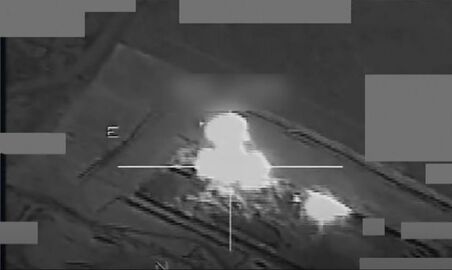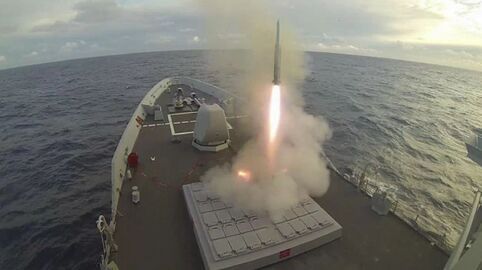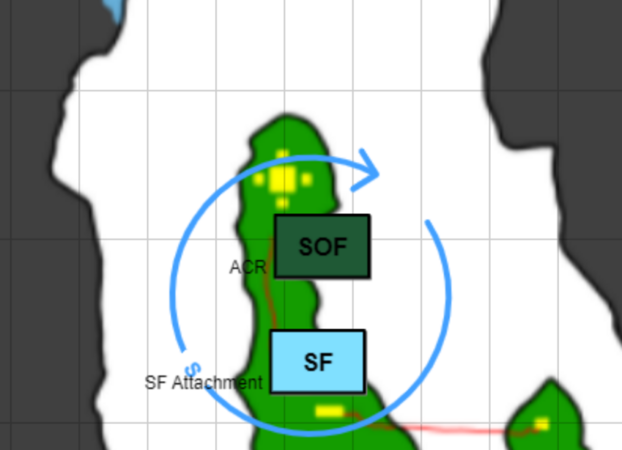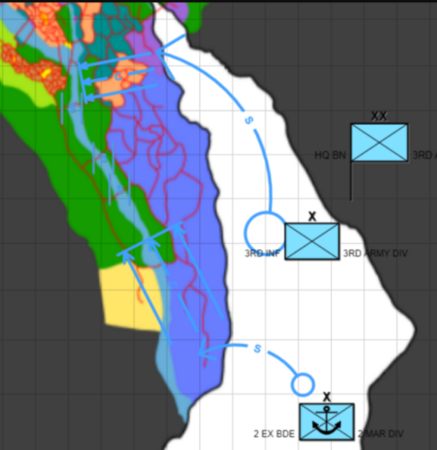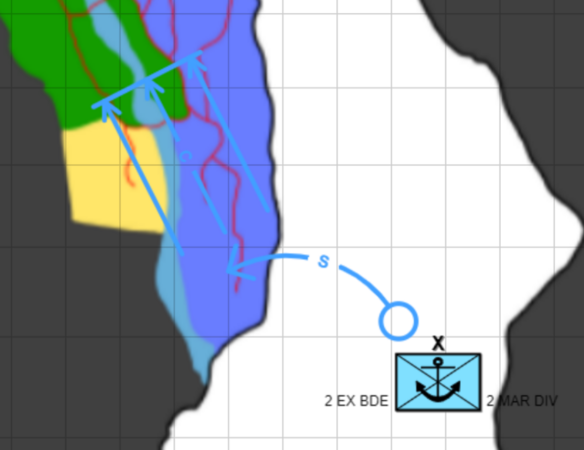Akanatoa War
| Akanatoa War | |||||||
|---|---|---|---|---|---|---|---|
| Part of Akanatoa Unrest | |||||||
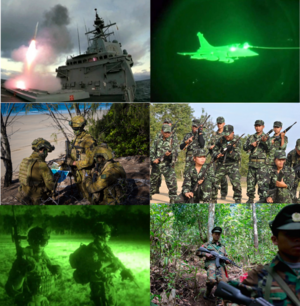 Akanatoa War | |||||||
| |||||||
| Belligerents | |||||||
| Commanders and leaders | |||||||
| |||||||
The Akanatoa War is an ongoing military conflict between Pelaxia, Takatta Loa and the Akanatoa Nationalists.
Background
Akanatoa has historically been a site of significant political unrest and economic underdevelopment due to neglect and uneven distribution of governmental development projects. In part this stems from racial prejudice, as Akanatoa has a significant amount of Non-Loa Polynesians who face significant discrimination. As a result, criminal groups have made their home in Akanatoa, most notably the Hoa'akara Cartel, which has ties to the larger Trans-Vallosian cartels. They have been especially successful at bribing and planting government officials with numerous Akanatoa legislators being imprisoned for associations with the cartel. Chieftain Kalauenda had the reputation of being heavily associated both by blood relations and by economic ties to the Hoa'akara, but has never been successfully investigated by the government of Takatta Loa.
Chieftain Kalauenda has been linked with Pelaxian local terrorist and separatist organization from the province of Savria. Under the purview of E4 commitments Pelaxia has been carrying out counter-smuggling operations over the Kindred Sea to deny Loa smugglers free movement in the sea and prevent them from smuggling weapons into Pelaxia.
The Pelaxian Ministry of Defense produced an extensive intelligence report linking the smuggling activities to the Chieftain Kalauenda of Akanatoa. Through this, the Federal Chancellor Valladolid instructed its Primer Minister, Pedro Meireles, to carry out the arrest and/or elimination of the responsible groups devising these activities.
Outbreak

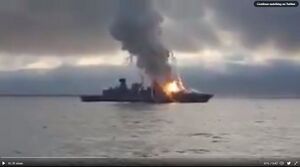
On January 2026 two "Guardia Civil" officers were shot and killed at a checkpoint 10 kilometers away from Leg in Savria. These attacks were claimed but the re-formed separatist organizartion FLNS. During the month of January and February, Federal Civil Guard elements cracked down on the attackers. Guardia Civil's presence in Savria and its capital Tabăra was to be reinforced as provincial elections approached. Meireles' reportedly snapped at the Joint Chiefs of Staff "No Fuckery" around the Operation Mare Nostrum, reported RMC News.
From the operartion carried out by the Guardia Civil, it was alleged that the guns used by the FLNS have not been funneled from within Anastasio Torque Autonomous Community, and later the Minisitry of Interior, Ministry of Security and the DISEN were instructed to elaborate a comprehensive report on the matter. This report, later titled the "Weapons Lane " report detailed a connection between high-ranking chiefs of the Akanatoa region and FLNS militants.
Prime Minister Meireles lauched Operation "Mare Nostrum" through national security powers. Naval elements expanded its area of operation and assets in the Kindred Sea to police and secure maritime lanes under the E4 purview and capacity. "This a direct response to the pressure he is handling after the arms smuggling in Sawra", a government insider said at the time. This marked the first time a Prime Minister made use of the Smart Defense Act, which gives the Prime Minister powers for emergency military deployment abroad and support of federal forces internally by declaring a state of exception in the event of an explicit threat to national security, if the government of Takatta Loa does not extradite regional leaders implicated by the Ministry of Interior in the "Weapons Lane" Report. Political advisors and Chiefs of Staff were described as "uneasy" by a source.
By late February a large concentration of Pelaxian military assets on key strategic naval bases and ports was noticeable by several media outlets and even several family members of Pelaxian service men went on social media expressing concerns for their relatives being called upon to their bases.
On March 20th, the Ministry of Defense reported 1 dead and 2 injured during and attack to a Pelaxian frigate. The Pelaxian Navy confirmed the Gutierrez Class Frigate "NAP Aureliano Castro" was impacted by a weapons smuggling boat loaded with explosives, as a second boat avoided the patrol task force. "This shows an upgrade in Loa smuggling tactics who are willing to target military and security personnel in the Kindred", the Navy report said. From the images shared on Ixtwitter, the explosion triggered an on-deck fire and fire protocols were initiated. One sailor was confirmed deceased on board, while another two were injured.
Later that month in Takatta Loa, Galuenda was called before the legislature to answer for these connections which were verified by Loa sources. He refused to show, instead sending an address stating that he along with several other chieftains and their territory would be leaving the nation. The associated legislators either fled, complied or in one case was executed for Loa sympathies. Takatta Loa began immediate mobilization, with cooperation between Pelaxia approved.
By March 2026 full mobilization was issued to the Pelaxian Armed Forces, and by May Operacion Cimitarra was approved.
Operación Cimitarra
Kalauenda Raid

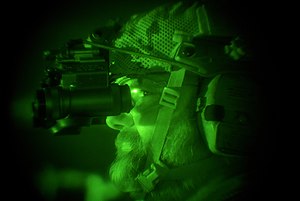
On March 13th, two battalions of the 1st Pioneers Regiment ("Pioneros") and one company of the 1st Rapid Aerial Response Battalion (1st RAR) landed on Akanatoa territory by a swimmer delivery vehicle and inflatable boats under cover of the night. Their mission was to kill or capture Chieftain Kalauenda and other 5 of his generals. The Pioneers were to screen and gather intelligence on the military capacity of the Akanatoa forces around Imahenda and to track the movements of Kalauenda, awaiting approval to strike. The combined special operations task force was instructed to create and secure a supply landing zone to substain them vía nocturnal air drop from an A-400M.
On the night of March 31st Operación Cimitarra is green lit and the company of the 1st RAR engages Kalauenda’s escort convoy 30 kilometers away from Imahenda. The Ministry of Defense will later report that 3 members of the High Chieftain of Akanatoa General Staff have been killed during an operation carried by the 1st Rapid Aerial Response Battalion (1st RAR) that has been deployed over the region in advance of Operation Cimitarra.
Afterwards 1st RAR was to continue gathering intelligence on key strategic objectives such as ammo depots, radio towers and anti-air positions and secure a supply landing zone for the rest of the special forces in the area. While the 1st Pioneers Regiment were tasked to destroy already marked installations such as radar instalations. The intelligence and marking of objectives carried out by the Pioneers and the 1st RAR would be key to the following SEAD operation carried out by the Pelaxian Navy and its air assets.
Sea and Air Operations
On the 1st of April the Pelaxian Task Force already lurking in the Akanatoa waters started its SEAD operations to destroy or deny the enemy infrastructure and establish a No Fly Zone over Akanatoa for the following land campaign.
The maritime task force was composed of
- 2 aircraft carriers,
- 20 frigates,
- 4 submarines,
- 30 corvettes,
- 8 Amphibious transport docks and
- 2 landing ship tanks.
-
Jerónimo I being escorted
-
Rafale M takes off on a bombing mission.
-
Akanatoa ammo depot being hit.
-
Pelaxian navy frigate Hugo Charpantier engaging a hostile aircraft.
Together this fleet amassed a force of 160,000 personnel of the Pelaxian Armed Forces and the Federal Civil Guard.
Air raids from the Enterprise Class "Jernónimo l" aircraft carrier began in the morning with Burgundian Rafale M and Urcean F4 Phantoms, making up to 40 sorties per day engaging several ground objectives identified by the special forces on the ground. As per maritime strategy the frigate escort provided anti air protection to the carriers, engaging several Akanatoa small aircraft that threatened the operation of the task force.
By the 10th of April nearly all the stationary and logistical reserves of the Akanatoa militia has been destroyed, and the Task Force controlled the airspace over the province.
Ground Operation
First Amphibious Operation
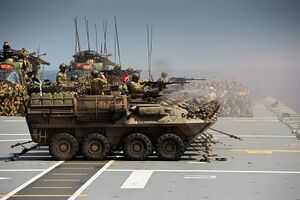
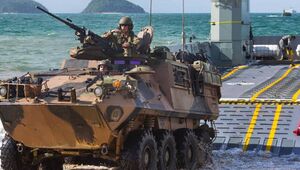
A heavy land base of operations was key for the following land invasion of Operación Cimitarra. The lack of this base would compromise any big land unit that intended to operate in mainland Akanaoa. Eventually a plan was hatched to capture the Prima Island right off the coast of the Imahenda delta. The plan was to carry out an amphibious landing by Pelaxian Marine forces the 12th of April, eject the small Akanatoa presence and establish an airbase on the island.
The success of this operation would depend on the performance of the Pelaxian Marine Corps whose task was to get ashore and physically capture the Akanatoa garrison.
Following the capture of Prima Island, Base Irunga began construction as the main operating base for the combined Pelaxian forces, and to become the biggest foreign operating base of the Pelaxian Armed Forces to date.
Base Irunga would be the seat of the theater command for the rest of the operation.
Airborne Deployment in the North
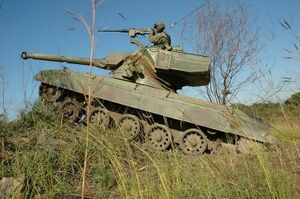
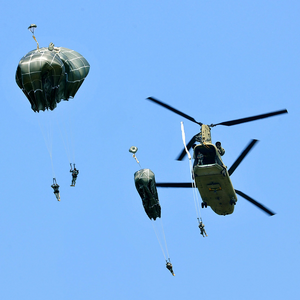
The 813th Air Recon Battalion embarked on CH - 47s and Aérospatiale SA 330 Pumas to perform an air assault landing on Sulaga city, intending to land in the mountains, secure a strategic airfield 10 kilometers from the area to channel in reinforcements and begin to surround the city. This key airfield was nicknamed “La pista de oro” / “The golden strip” some platoons had to switch abruptly to a parachute landing when they learned mid-flight that some landing zones were contested. The air drop began at 03:30 on April 13th in the face of heavy resistance from anti-aircraft guns and several small arms fire. Dassault Rafale M provided support for the landing.
Local construction vehicles were commandeered to help clear landing zones and roads, and one even used to provide mobile cover for the troopers as they moved to seize the heights surrounding the roads.The troopers secured several road junctions and bridges leading to the city by 08:00 AM, and transport planes were able to land and unload additional reinforcements.
By 10:00 “The golden strip” was secured enabling Airbus A400-M to land several SK-105 tank destroyers to provide fire support for the following troops. Starting at 12:00, troops began landing from the 801st and 802nd Parachute Regiments. Troopers from the 813th fanned out and secured the surrounding area, negotiating the surrender of over 300 Akanatoas in an aviation hangar.
At 15:30, major firefights were reported as local militia started counterattacking.
Marine landing at Banaluekono
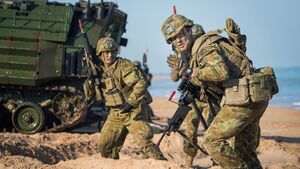
On April 20th the NAP Enrico, Unión, and Laureano, carrying the 1st Marine Expeditionary Legion under Condestable General Carlos Algabo, deploy the spearhead of the naval infantry operation on the city of Banaluekono, 20 kilometeres away from Imahenda.
First ashore was the Battalion Landing Team 3/9, which arrived on the beach at 8:15 a.m. Wearing full battle gear and carrying RAP-18s, the Marines were met with small arms fire on the beach. Within two hours, Battalion Landing Team 1/3 began landing.
The 7,000 Marines were deployed to secure the town’s airstrip, freeing local rebel militia up for combat. The Marines successfully create a secure beachhead for the rest of the Division, in order to create a second front West of Imahenda and advance north cutting off any Akanatoa forces trying to run into friendly provinces.
Battle of Imahenda
Preparations
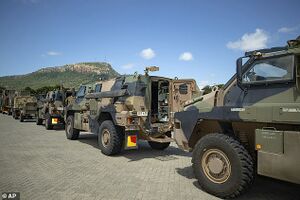
Before beginning their attack, Pelaxian special forces had established checkpoints around the city to prevent anyone from entering, and to intercept enemy fighters attempting to flee. In addition, overhead imagery was used to prepare maps of the city for use by the attackers. Pelaxian units were augmented by Loa local interpreters to assist them in the planned fight. After weeks of withstanding air strikes and artillery bombardment, the Akanatoa fighters in the city appeared to be vulnerable to direct attack. Pelaxian Army, Marines, Navy and Special Forces totalled 71,200. The Pelaxian High Command had gathered a complete Marine division of 20,000 and two Army division of 51,600 soldiers that would take part in the assault, with about 2,500 Navy and Special Forces personnel in operational and support roles.
Troops were grouped in three Divisions comprising the "Cuerpo de Armas Combinadas de Imahenda" (Imahenda Combined Arms Corps)
2nd Marine Division
'2nd Expeditionary Legion
- 1st Mechanized Marine Regiment
- 2nd Marine Regiment
- 2nd Mechanized Marine Regiment
- 4th Marine Regiment
- 5th Marine Regiment
- 6th Marine Regiment
- 2nd Marine Artillery Regiment
- 3rd Marine Logistics Regiment
- 4th Marine Logistics Regiment
- 2nd Marine Engineer Regiment
- 3rd Marine Engineer Regiment
1st Army Division
1st Infantry Legion
- 45th Termian Regiment
- 1st Air Cavalry Regiment
- 15th Artillery Batallion
- 134th Air Defence Batallion
- 33rd Engineer Batallion
- 35th Comms Batallion
- 54th Logistics Regiment
- 1st Medical Batallion
1st Mechanized Birgade
- 61st Dragoons Regiment
- 142nd Mech. Infrantry Regiment
- 92nd Artillery Batallion
- 7th Air Defence Batallion
- 34th Engineer Batallion
- 36th Comms Batallion
- 55th Logistics Regiment
- 2nd Medical Batallion
1st Armor Birgade
- 1st Armored Cavalry Batallion
- 143rd Mech. Infrantry Regiment
- 2nd Artillery Regiment
- 40th Air Defence Regiment
- 12th Engineer Batallion
- 13th Engineer Batallion
- 75th Engineer Batallion
- 37th Comms Batallion
3rd Army Division
3rd Infantry Legion
- 44th Infantry Regiment
- 135th Air Defence Batallion
- 33rd Engineer Batallion
- 35th Comms Batallion
- 60th Logistics Regiment
- 1st Tactical Air Transport Squadron
- 7th Medical Batallion
4th Infantry Legion
- 14th Motorized Infantry Regiment
- 5th Artillery Batallion
- 9th Air Defence Batallion
- 37th Engineer Batallion
- 41st Comms Batallion
- 61st Logistics Regiment
- 8th Medical Batallion
Special Forces Attachment
- 1st Rapid Aerial Response Batallion (1st RAR)
- 1st Halberd Legion Regiment (1st RAL)
All the BOCs were supported by Marine fixed and rotary-winged aircraft, Navy and Air Force fixed-wing aircraft; 1st Rapid Aerial Response Batallion (1st RAR) teams, 1st Halberd Legion Regiment (1st RAL) battalions and corresponding units from the Logistics and Medical Common Corps.
The 1st Rapid Aerial Response Batallion (1st RAR) was ordered to help with the encirclement of Imahenda. As part of the support elements (TBD Unit from Arcerion) prepared to take part in the operation.
Akanatoa Forces
Imahenda was defended by about 15,000 "regulars" and 5,000+ "part time" conmbatants. Imahenda was occupied by virtually every military unit from the Akanatoa Ipa: TBD,TBD,TBD,TBD.
The Akanatoa forces present in the city prepared fortified defenses in advance of the anticipated attack. They dug tunnels, trenches, prepared spider holes, and built and hid a wide variety of IEDs. In some locations they filled the interiors of darkened homes with large numbers of propane bottles, large drums of gasoline, and ordnance, all wired to a remote trigger that could be set off when troops entered the building. They blocked streets with Jersey barriers and even emplaced them within homes to create strong points behind which they could attack unsuspecting troops entering the building.
The Akanatoa forces were equipped with a variety of advanced small arms, APCs, trucks, body armor, uniforms and helmets. They booby-trapped buildings and vehicles, including wiring doors and windows to grenades and other ordnance. Anticipating tactics to seize the roof of high buildings, they bricked up stairwells to the roofs of many buildings, creating paths into prepared fields of fire which they hoped the troops would enter.
Intelligence briefings given prior to battle reported that Pelaxian forces would encounter Istrenyan, and Daxian combatants, as well as native Akanatoas.
Phase 1
Special Forces Attachment secures Gulf Island: Both the Pelaxian 1st Rapid Aerial Response Batallion (1st RAR) and the Arco Commando served as the main effort on the island and supported by the 1st Halberd Legion Regiment (1st RAL). These initial attacks, however, were aimed to secure access to the city’s gulf and establish a base for artillery and forward command posts on the small island covering the mouth of the river.
The island was mainly unguarded with only small groups of armed Akanatoa militias. A special force attachment was trusted with this operation in order to minimize collateral damage to sacred and holy places that were present all over the territory. 1st RAR landed at 11.00 and around 13.00 the 1st RAL encountered small arms fire that was quickly taken care of. By 15.00 the whole island was considered secured and no damages to holy structures were reported.
The island would be used as a base for command and support units following the next phase of the invasion. Artillery units began to be air dropped by 16.00 and by 20.00 a Forward Operating Base was under construction.
-
Phase 1": Pelaxian and Arco Special Forces Attachment
-
Phase 2 and 3 in tandem
-
The beginning of Phase 2: the 2nd Marine Division moving along the river
Phase 2
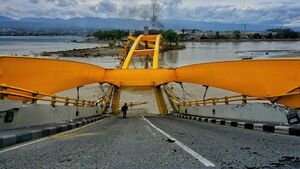
After the 2nd Marine Engineer Regiment interrupted and disabled electrical power at two substations located just northeast and northwest of the city. At the same time, one batallion of the 1st Halberd Legion Regiment (1st RAL) secured the electrical power station southwest of the city.
Once the main special forces elements have secured these key infrasatructure, the 2nd Expeditionary Legion of the 2nd Marine Division launched an attack along the southern coast of the city, right over the industrial sector. The marines were to clear the initial landing site in order to spearhead the advance over the key industrial sector of the city. Advancing north and following the river on both the west and east bank, their objective was to clear the industrial sector of any enemy presence and secure three bridges for later demolition. The destruction of the bridges would pocket any Akanatoa forces east of the river.
Phase 3: 3rd Army Division Lands
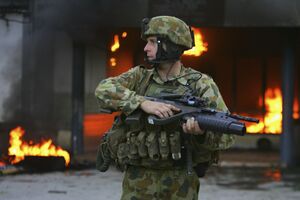
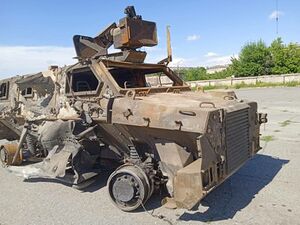
After securing the electrical power stations and clearing the initial landing site, the 2nd Expeditionary Legion of the 2nd Marine Division advanced north along the river to secure the key industrial sector of the city. Their objective was to clear the area of any enemy presence and secure three bridges for later demolition, in order to trap any Akanatoa forces east of the river.
Meanwhile, the 3rd Army Division was preparing to launch a strategic operation to further reinforce the Pelaxian apmhibious operation. They landed on the main port area of the capital, with the mission to secure both banks of the port area united by the main bridge, and then link up with the 2nd Marine Division and relieve them as an in-depth landing force. The 3rd Army Division brought in additional troops and equipment to bolster the Pelaxian landing in the city. They secured the southern flank of the operation and coordinated with the 2nd Marine Division to continue the advance towards the city's business sector. Despite facing stiff resistance from Akanatoa forces, the Pelaxian military's strategic planning and well-coordinated operations enabled them to make steady progress towards achieving their objectives. With the arrival of the 3rd Army Division, the Pelaxian military's position in the city was further strengthened, giving them a significant advantage in the ongoing battle.
In addition to reinforcing the Pelaxian military's position in the city, the 3rd Army Division had a final objective to advance towards the key governmental buildings in the city, advancing through the business sector first. This was a critical target that needed to be secured in order to gain control of the city and establish a strong foothold for future operations. The 3rd Army Division began their advance towards the governmental buildings, coordinating closely with the 2nd Marine Division and other special forces units in the outskirts of the city. They faced stiff resistance from Akanatoa forces who were fiercely defending their capital city, but the Pelaxian military's well-coordinated operations enabled them to steadily push forward towards their objectives.
With the support of air and artillery units, the 3rd Army Division made significant progress towards their objective, securing key positions and eliminating enemy resistance along the way, while at the same time sustaining heavy losses in equipment and manpower due to less than adequate protection for high intensity urban combat. Despite facing difficult conditions, the Pelaxian military's determination and superior tactics enabled them to achieve their objectives and establish a strong foothold in the region.
During the intense combat in the government district, the 3rd Army Division faced heavy engagement both during the day and relentless surprise counterattacks at night. The Akanatoa forces, determined to defend their capital, launched fierce assaults to dislodge the Pelaxian military from their positions. The 3rd Army Division, however, withouth heavy armor support as it did not have a main battle tank suited for intense urban combat, remained resilient and adapted their tactics to effectively respond to these challenges.
One crucial element that proved vital in disrupting enemy resistance and enabling the division to achieve its ground objectives was the close air support provided by a formidable array of aircraft. The Rafale Ms, AV-8A Harriers, and CASA C-101 Aviojets played a pivotal role in delivering airstrikes on enemy strongholds, troop concentrations, and armored assets. These aircraft conducted precision and "area" strikes, obliterating key enemy positions and infrastructure, weakening their defensive capabilities.
Under the cover of darkness, when the Akanatoa forces attempted surprise counterattacks, the Pelaxian military relied on the timely and accurate air support from the aforementioned aircraft. The Rafale Ms, with their advanced sensors and weapons systems, engaged enemy targets with precision-guided munitions, effectively disrupting the enemy's momentum and inflicting significant damage. The AV-8A Harriers, known for their versatility and vertical takeoff capabilities, provided close air support and supply deliveries in this urban environment. Additionally, the CASA C-101 Aviojets, renowned for their agility and firepower, launched coordinated "area" strikes, suppressing enemy movements and providing critical support to ground troops, effectively neutralizing enemy combatants and fortifications
These combined efforts of ground forces and close air support were instrumental in maintaining the momentum of the 3rd Army Division's advance and inflicting heavy losses on the Akanatoa forces. By day, ground troops pushed forward, securing key positions and eliminating enemy resistance with the support of airstrikes. At night, the Pelaxian military effectively disrupted enemy counterattacks through coordinated operations, utilizing the close air support to neutralize threats and maintain control over their gained ground.
Despite the challenges faced and the heavy losses sustained, the 3rd Army Division's unwavering determination, combined with the strategic use of air assets, allowed them to persevere and achieve their objectives in the face of a formidable enemy. Their ability to adapt to changing conditions, exploit opportunities, and leverage their air superiority ultimately proved crucial in establishing a firm foothold and ending the Pelaxian military's campaign in the city.
While most of the fighting subsided by 13 May, the Pelaxian Marines and Special Operations Forces continued to face determined isolated resistance from insurgents hidden throughout the city. By 16 May, after nine days of fighting, the Marine command described the action as mopping up pockets of resistance. Sporadic fighting continued until 23 June.
Death of Kalauenda: Operation Deguello
In the waning days of the Akanatoan conflict, the theater of war had shifted, and a new set of challenges and objectives had emerged. The protracted struggle had taken a heavy toll on both the Pelaxian government and the Akanatoan forces, creating an environment ripe for alliances and pivotal operations.
The turning point in the war came when a daring and meticulously planned operation led to the capture and ultimate elimination of Kalauenda, the enigmatic and embattled cartel leader who had plunged the region into chaos. A clandestine alliance of local Loa forces, with the crucial backing of Pelaxian military advisors, managed to apprehend Kalauenda in a covert operation that drew on intelligence networks from both Pelaxia and Loa. This momentous event sent shockwaves through the Akanatoan insurgent ranks, destabilizing their already fragile unity. The capture of Kalauenda stands as a watershed moment in the Akanatoan War, marking a significant turning point that would set the stage for the conflict's conclusion.
In the late night hours of November 9, 2032, a clandestine alliance of local forces, known for their exceptional combat skills, embarked on a daring mission deep within outskirts of Legada. This combined group was complemented by Pelxian 1st RAR soldiers and the 45th Termian Regiment who had extensive experience in asymmetric jungle warfare. The operation was born from a synergy of intelligence networks, meticulously coordinated by both Pelaxia and the Takatta Loa government. Precise information concerning Kalauenda's location and his immediate security detail was gathered over months of painstaking work by dedicated operatives.
As darkness cloaked the Akanatoan wilderness, the combined team moved stealthily toward their objective. Their actions were shrouded in silence and executed with clinical precision. The element of surprise was absolute, taking full advantage of the sparsely inhabited and densely forested environment, ensuring the enemy was caught off guard. In the ensuing engagement, an intense firefight erupted as the special forces closed in on Kalauenda's hidden safehouse. Although the enemy offered a fierce resistance, the tactical expertise of the Pelaxian advisors and the cover of the local special forces gradually tightened the net around Kalauenda and his loyalists. By the early morning of November 10, Kalauenda has been reported killed. Kalauenda, the enigmatic and embattled cartel leader, was ultimately eliminated, as successful operation unraveled the core of the rebel network.
The capture and elimination of Kalauenda sent shockwaves through the ranks of the Akanatoan insurgents, undermining their unity and resolve. This event marked a turning point in the Akanatoan War and paved the way for the subsequent transition to settling the conlfict and facilitating stability in the region.
Nothern pacification: Operation Yunque
Following the elimination of Kalauenda, the intricate choreography of the war's endgame took center stage. The rebel forces, now rudderless and in disarray, had lost their charismatic and enigmatic leader, and a power vacuum began to emerge. In response to this strategic shift, both the Pelaxian and Loa Republic high commands saw an opportune moment to declare a formal cease to large-scale military operations.
The transition to peace was underpinned by a military operation in the highlands carried out by the 1st Airborne Legion garrisoned across the mountainous valley. In mid November 2032, Opetation Yunque was green lit and the 800th Parachute Regiment, 801st Parachute Regiment, 802nd Parachute Regiment and 813th Air Recon Batallion went on an offensive raid of key urban centers in northern Akanatoa. As the vanguard of the transition, they played a pivotal role in securing the key areas left in disarray by the sudden vacuum of rebel power.
Their presence in the affected regions was an unmistakable symbol of both strength and commitment to the peace process. Their deployment across the most volatile regions signaled that the military high commands were prepared to enforce the cease of large-scale military operations rigorously. In regions where the rebels had once held sway, the 1st Airborne Legion brought finally security and stability.
Transition
In the wake of the cessation of large-scale military operations and the pivotal elimination of Kalauenda, the Akanatoan conflict entered a new phase. It was a period of transition, from the intense battles and gruelling ocupation and security operations of the past to the delicate work of steadily pacifying and abandoning the land. The success of this transformative stage rested heavily upon the strong and capable shoulders of the "Mountain Wolves Brigade," a renowned unit skilled in the complexities of mountain warfare, counterinsurgency, and pacification operations.
As the conflict in Akanatoa shifted gears, the involvement of the Pelaxian military began to wane, making way for the ascendance of the Loa Republic in managing its own security and military operations. This significant transition marked a turning point in the journey towards stability and self-governance. The summit of Loa leaders was a critical juncture in the timeline of this transition. Key figures from the Loa Republic, both military and political, convened at Imahenda to forge a comprehensive strategy for assuming control of their nation's security. The primary objective was to ensure a seamless handover of authority while preserving the gains made during the joint operations with Pelaxia.
At the heart of this transition was the 2nd Expeditionary Legion of the 2nd Marine Division and attatchment of the Federal Civil Guard, who have been occupying the capital of Akanatoa since the firs amphibious operation. While their mission initially focused on quelling the remnants of Akanatoan forces and later supressing any insurgent uprising, it soon evolved to serve as a guiding light for the incoming Loa military.
The Loa leadership recognized the expertise and experience that the Federal Civil Guard brought to the table. With their help, Loa forces would learn the intricacies of counterinsurgency tactics, community engagement, and military-civilian coordination. This exchange of knowledge was pivotal in ensuring that the Loa Republic could independently address its own security concerns.
The FCG was instrumental in training Loa soldiers, imparting valuable lessons in distinguishing insurgents from non-combatants and fostering connections with local communities. The Loa Republic's military gradually took over responsibilities and established its presence in areas previously patrolled by Pelaxian forces. As Loa Republic forces assumed control, the Pelaxian military began its gradual withdrawal from mainland Akanatoa. The FCG played a dual role, not only as a skilled policing unit but also as advisors and liassons during this period. Their dedication and commitment to a smooth transition helped instill confidence in the Loa leadership and military, setting the stage for the Loa Republic to take charge of its own security.
The transition of military responsibility was a defining phase in the post-conflict landscape. It signified the empowerment of the Loa Republic, as they assumed full control of their national security. This change allowed Pelaxia to redeploy its forces elsewhere, all while maintaining a mutually beneficial relationship with the Loa Republic, with a shared commitment to regional stability and prosperity.
Aftermath
Imahenda Accords
The Imahenda Accords, stood as a landmark bilateral agreement between the Loa Republic and Pelaxia. This historic pact was characterized by three key points that would significantly shape the future of their relationship and regional dynamics.
Establishment of a Permanent Pelaxian Air-Naval Base in Akanatoa: The heart of the Imahenda Accords lay in the establishment of a permanent Pelaxian Air-Naval base off the coast of Akanatoa, an endeavor both nations embarked upon with mutual understanding. The choice of this location, named Base Irunga, was strategic and aimed at maximizing regional security and cooperation. The Accords defined the terms of operation, detailing the rights and responsibilities of both parties, ensuring that the base would serve as a platform for regional stability.
Withdrawal of All Pelaxian Military Personnel from Mainland Akanatoa: In an unmistakable gesture of good faith, Pelaxia committed to the full withdrawal of its military personnel from mainland Akanatoa. This marked the end of an era defined by military presence and ushered in a new era where the Loa Republic would take charge of its internal security and stability. The withdrawal was a process carefully executed to ensure a smooth transition, setting the stage for the Loa Republic to assert its sovereignty over its territory.
A 100-Mile Prohibited Zone for Non-Pelaxian Military Vessels: One of the cornerstones of the Imahenda Accords was the delineation of a 100-mile prohibited zone off the Akanatoan coast. This exclusive maritime zone was reserved for Pelaxian military vessels, ensuring that the sea routes near Akanatoa would be secured and monitored by Pelaxian Navy. The zone stood as a buffer against potential threats and external interference, enhancing regional stability and security of this key entrance to the Kindred Sea.
The Imahenda Accords were a testament to the commitment of both the Loa Republic and Pelaxia to safeguarding the future of the Akanatoan region. They marked the beginning of a new chapter where cooperation, shared security, and mutual respect were the guiding principles of their relationship. With the signing of the Imahenda Accords, the two nations looked forward to a future where they worked in harmony to secure their shared interests and foster prosperity in the region.
Amid these challenges, the Imahenda Accords fostered a strengthening of diplomatic relations between the Loa Republic and Pelaxia. Both nations recognized the importance of maintaining a constructive dialogue and finding common ground in the post-conflict era. Through regular diplomatic channels, they worked on areas of cooperation, economic collaboration, and regional security.
The political aftermath of the Imahenda Accords was a dynamic and evolving landscape, marked by both progress and persistent challenges.
The permantent establishment of Base Irunga marked a significant milestone in the transition from a theater of conflict to a stable and secure region. Situated off the coast of Akanatoa, Base Irunga was envisioned as a permanent Pelaxian Air-Naval facility, playing a pivotal role in regional security and cooperation. The development of Base Irunga was guided by an array of maritime and aerial assets operated by the Pelaxian Navy. The base would be allowed and able to sustain a diverse fleet that included frigates, submarines, and a range of support vessels, two regiments of Pelaxian Marines at all times while another was in rotation and at least a squadron of Rafale fighter jets. These assets were integral to enforcing the agreement of a forward operating base, which would serve as a safeguard against any resurgence of rebel factions or potential external threats that the Loa Republic could face within Vallos.
The development of Base Irunga was met with a degree of local support and partnership, as the Loa Republic recognized the benefits of having a strategic Pelaxian facility in the region.
Pelaxian Irredentism
One of the key accomplishments of the Imahenda Accords was the mitigation of irredentist sentiments within Pelaxia. Irredentism, a political movement advocating the reintegration of lost territories, had simmered in the background, particularly concerning Takatta Loa. The withdrawal of Pelaxian military personnel from mainland Akanatoa and the establishment of Base Irunga signaled a willingness to respect the sovereignty of the Loa Republic, effectively quelling these irredentist voices. However, the Accords did not silence all critics. Skeptics voiced concerns over the potential for a neocolonial relationship, questioning the true motivations behind the establishment of a permanent Pelaxian Air-Naval base.
The home front
The Akanatoan conflict had resulted in a significant loss of Pelaxian lives. This loss weighed heavily on the public and the government alike. Families of fallen soldiers, veterans, and a war-weary populace demanded accountability and justice for the sacrifices made. The Accords necessitated an introspective look at the costs of military interventions and raised calls for improved strategies and better equipment for urban warfare scenarios.
The glaring inadequacy of the Pelaxian military in urban warfare had been laid bare during the conflict. The urban warfare environment in Akanatoa had exposed a need for significant military reform, pushing for more adaptive training, urban warfare simulation, and adecquate vehicles. The government faced pressure to reevaluate military doctrine and invest in modernization to meet contemporary challenges.


